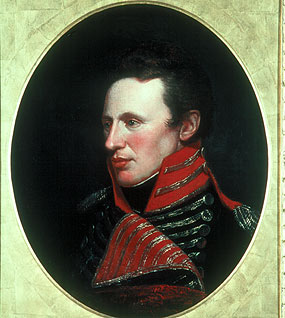Related Research Articles

The Hudson's Bay Company is a Canadian, now American-owned, retail business group. A fur trading business for much of its existence, HBC now owns and operates retail stores in Canada and the United States.

Karlheinz Stockhausen was a German composer, widely acknowledged by critics as one of the most important but also controversial composers of the 20th and early 21st centuries. He is known for his groundbreaking work in electronic music, for introducing controlled chance into serial composition, and for musical spatialization.

The Lewis and Clark Expedition from August 31, 1803, to September 25, 1806, also known as the Corps of Discovery Expedition, was the United States expedition to cross the newly acquired western portion of the country after the Louisiana Purchase. The Corps of Discovery was a select group of U.S. Army and civilian volunteers under the command of Captain Meriwether Lewis and his close friend Second Lieutenant William Clark. The expedition made its way westward, and crossed the Continental Divide of the Americas before reaching the Pacific Coast.

New Netherland was a 17th-century colony of the Dutch Republic that was located on what is now the East Coast of the United States. The claimed territories extended from the Delmarva Peninsula to southwestern Cape Cod, while the more limited settled areas are now part of New York, New Jersey, Delaware, and Connecticut, with small outposts in Pennsylvania and Rhode Island.

The furry fandom is a subculture interested in anthropomorphic animal characters with human personalities and characteristics. The term "furry fandom" is also used to refer to the community of people who gather on the Internet and at furry conventions, or otherwise participate in the subculture. Individual members of the fandom are known as "furries".

Louis Jolliet was a French-Canadian explorer known for his discoveries in North America. In 1673, Jolliet and Jesuit Father Jacques Marquette, a Catholic priest and missionary, were the first non-Natives to explore and map the Upper Mississippi River.

New France was the area colonized by France in North America, beginning with the exploration of the Gulf of Saint Lawrence by Jacques Cartier in 1534 and ending with the cession of New France to Great Britain and Spain in 1763 under the Treaty of Paris.

Jedediah Strong Smith, was an American clerk, transcontinental pioneer, frontiersman, hunter, trapper, author, cartographer, and explorer of the Rocky Mountains, the North American, West, and the Southwest during the early 19th century. After 75 years of obscurity following his death, Smith was rediscovered as the American whose explorations led to the use of the 20-mile (32 km)-wide South Pass as the dominant point of crossing the Continental Divide for pioneers on the Oregon Trail.

Pemmican is a mixture of tallow, dried meat, and sometimes dried berries. A caloric rich food, it can be used as a key component in prepared meals or eaten raw. Historically, it was an important part of indigenous cuisine in certain parts of North America and it is still prepared today. The word comes from the Cree word ᐱᒦᐦᑳᓐ, which is derived from the word ᐱᒥᕀ, "fat, grease". The Lakota word is wasná, originally meaning "grease derived from marrow bones", with the wa- creating a noun, and sná referring to small pieces that adhere to something. It was invented by the Indigenous peoples of North America.

Zebulon Montgomery Pike was an American brigadier general and explorer for whom Pikes Peak in Colorado was named. As a U.S. Army officer he led two expeditions under authority of President Thomas Jefferson through the Louisiana Purchase territory, first in 1805–1806 to reconnoiter the upper northern reaches of the Mississippi River, and then in 1806–1807 to explore the southwest to the fringes of the northern Spanish-colonial settlements of New Mexico and Texas. Pike's expeditions coincided with other Jeffersonian expeditions, including the Lewis and Clark Expedition and the Red River Expedition in 1806.

Sir Alexander Mackenzie was a Scottish explorer known for accomplishing the first east to west crossing of America north of Mexico in 1793, which preceded the more famous Lewis and Clark Expedition by 12 years. The Mackenzie River is named after him.

A mountain man is an explorer who lives in the wilderness. Mountain men were most common in the North American Rocky Mountains from about 1810 through to the 1880s. They were instrumental in opening up the various emigrant trails allowing Americans in the east to settle the new territories of the far west by organized wagon trains traveling over roads explored and in many cases, physically improved by the mountain men and the big fur companies originally to serve the mule train based inland fur trade.

In the 19th century, the Oregon Country was a disputed region of the Pacific Northwest of North America. The region was occupied by British and French Canadian fur traders from before 1810, as well as American settlers from the mid-1830s, with its coastal areas north from the Columbia River frequented by ships from all nations engaged in the maritime fur trade, most of these from the 1790s through 1810s being Boston-based. The Oregon Treaty of 1846 ended disputed joint occupancy pursuant to the Treaty of 1818 and established the British-American boundary at the 49th parallel.
Dark wave is a music genre that emerged from the new wave and post-punk movement of the late 1970s. Dark wave compositions are largely based on minor key tonality and introspective lyrics and have been perceived as being dark, romantic and bleak, with an undertone of sorrow. The genre embraces a range of styles including cold wave, ethereal wave, gothic rock, neoclassical dark wave and neofolk.

The fur trade is a worldwide industry dealing in the acquisition and sale of animal fur. Since the establishment of a world fur market in the early modern period, furs of boreal, polar and cold temperate mammalian animals have been the most valued. Historically the trade stimulated the exploration and colonization of Siberia, northern North America, and the South Shetland and South Sandwich Islands.
John Christopher Fine of Scarsdale, New York is a marine biologist with a doctor of jurisprudence degree and has dived on shipwrecks all over the world. He is a Master Scuba Instructor and Instructor Trainer, and the author of over two dozen books on almost as many topics, including award-winning books dealing with ocean pollution. He has authored both fiction and non-fiction books.

The history of Oregon, a U.S. state, may be considered in five eras: geologic history, inhabitation by native peoples, early exploration by Europeans, settlement by pioneers, and modern development.
Alfred Ritscher was a German polar explorer. A Kapitän zur See in the Kriegsmarine, he led the third German Antarctic Expedition in 1938–39, which mapped the New Swabia territories of Queen Maud Land. Ritscher Peak and Ritscher Upland there are named for him.
Byrd Cloth is a type of fabric similar to Grenfell Cloth which was designed in the 1934 by Harris Thurston and heavily promoted by Antarctic explorer Richard Byrd. The material was considered windproof, yet the weave allowed some air to penetrate and therefore allowed sweat to evaporate from the body rather than freeze against the skin. It was meant to replace the fur-lined parkas which had traditionally been used for cold-weather exploration, and was discovered to also be ideal for World War II army uniforms because it absorbed less sweat, repelled mosquito bites, and was much lighter weight than the existing cotton twill uniforms worn by soldiers in the Pacific theater of the war.

A fursona is a personalized animal character created by someone in the furry fandom. The term fursona is derived from furry and persona. The vast majority of furries have fursonas; the Anthropomorphic Research Project states that nearly every furry has a fursona, and The New Science of Narcissism estimates the amount at 95%. The Anthropomorphic Research Project additionally states that the average furry has 2.12 fursonas over the course of their life.
References
- ↑ George, Lynn Early Explorers in New York: Native Americans and Europeans (Primary Sources of New York City and New York State) Publisher: Rosen Classroom (June 30, 2003) ISBN 0-8239-8402-8 ISBN 978-0823984022
- ↑ Peterson, Chris Birchbark Brigade: A Fur Trade History Boyds Mills Pr (October 1, 2009) ISBN 1-59078-426-X ISBN 978-1590784266